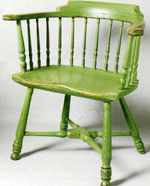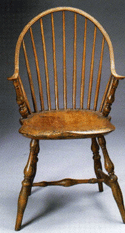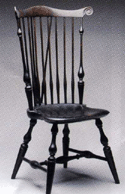|
Popular American Windsor Chairs Had Many Styles
By Anne Gilbert
American Windsor chairs have never gone out of fashion. These days, even
early 20th century reproductions can cost $300 and up. There have been many
variations with such descriptive names as fan back, bow back, birdcage, sack
back and comb back. There were also versions made for children and as
highchairs. They have been made non-stop in England and America for more than
three hundred years. When an 18th century American Windsor with original paint
and in a rare sack back form comes to auction, the price can be over $12,000.
According to legend, the Windsor had its origins with its discovery by King
George II in a peasant's cottage near Windsor Castle. Although crude in design,
the King found it so comfortable he had his cabinetmaker copy the design. This
first version was unpainted and had bark-covered stick legs, a plank seat and a
back with spindles. As it evolved, it was next painted with chalky green blue
paint, and the bark legs were replaced with turned, carved legs.
Windsors
were being made in England in quantities by the early 18th century. By 1740, the
American versions appeared first in Philadelphia. However, instead of the
straight legs made for English Windsors, American craftsmen set the legs at
sharp angles some buyers felt that reflected the growing independent feeling
in the Colonies. Between 1797 and 1800, American Windsors became so popular that
they were exported out of the country by the thousands.
There are six basic
types of American Windsors: sack back (bow), low back, comb back, hoop back, New
England arm, fan back and loop back, and with many variations. All types have
slender, round, upright spokes or spindles, turned and usually tapering upward.
Spindles may vary in number with those having the most spindles considered
choice by collectors. Highest prices generally are for comb back and
bamboo-turned armchairs. The use of bentwood often formed the back and arms.
Seats were made of a single plank and hollowed out in a saddle seat. The
spindles were fitted into holes in the hoop, loop or arms at the top. The legs
were pushed through the seat and fastened. It was this construction and the use
of both green and mature wood that resulted in chairs surviving centuries of
constant use.
CLUES: 18th and early 19th century Windsor chairs weren't made
from a single wood. Several woods were used. American Windsors usually had the
bow or hoop back of hickory and the legs of oak, hickory or maple. The spindles
were of hickory or ash. Mahogany arms are a clue to the mid- to late-19th
century. The seats were made from pine, whitewood or beech. To hide this
diversity of woods, the chairs were painted. Green, dark and apple green, Indian
red, black, gray, brown, or blue, and sometimes gold accents were used. Early
chairs were rarely stained.
Since by now most chairs have been stripped, look
for traces of the original paints. Be suspicious of new paint that has been
artificially aged. See if the feet have been "pieced" or cut down. Check the
spindles. If handmade, they will not be uniform.
|



Painted low back, bow back and fan back Windsors. (Photo, James Julia
Auctions, Fairfield, ME)
|